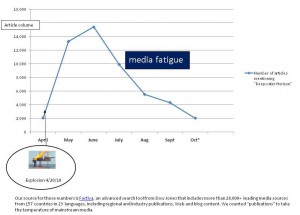The media decides what we’ll worry about. Today, that would be the economy, midterm elections, two wars, a tsunami, a new Bin Laden tape and a party drink dubbed “blackout in a can.”
 Nothing much on BP these days, so the Gulf of Mexico oil spill must be pretty much taken care of, right?
Nothing much on BP these days, so the Gulf of Mexico oil spill must be pretty much taken care of, right?
Not according to this article in USA Today, which reports that:
- The length of shoreline where oil is present has increased from 287 miles in early July to 320 today.
- In Bay Jimmy, La., alone, 32,000 gallons of oil were sucked up in a recent 10-day period.
- Oil, not surprisingly, is clinging tenaciously to marsh grass.
- Cooler fall and winter weather will thicken the oil and make it harder to extract.
- Cleanup worker count has dropped by nearly two-thirds, from 47,000 at the height of the spill to 16,200.
 The disaster hasn’t gone away, but where’s the media? Well, kudos to USA Today for the above info, and to Frontline for kicking BP’s tail on Tuesday night. But in general, the media follows the conflict, the drama and the fancies of its paying audience to those insipid places we yearn to go. As a result, we’ve moved on from Afghanistan. We’ve moved on from Haiti. And we’ve moved on from the Gulf of Mexico.
The disaster hasn’t gone away, but where’s the media? Well, kudos to USA Today for the above info, and to Frontline for kicking BP’s tail on Tuesday night. But in general, the media follows the conflict, the drama and the fancies of its paying audience to those insipid places we yearn to go. As a result, we’ve moved on from Afghanistan. We’ve moved on from Haiti. And we’ve moved on from the Gulf of Mexico.
To document this catastrophe fatigue, we searched for news stories on “Deepwater Horizon” (the name of the exploded rig and shorthand for the entire debacle) from April 2010 through Wednesday, Oct. 27 at 10:30 EST. Here’s what we found.
As you can see, the media bombards us with stories from April through July. Then the fatigue sets in. Just six months after the worst oil spill in history, the media is practically silent.
 But the problems remain. That’s why Sean Penn is still in Haiti. That’s why Billy Nungesser is still in Plaquemines Parish. That’s why BP workers are still cleaning up the oil – some of them, at least.
But the problems remain. That’s why Sean Penn is still in Haiti. That’s why Billy Nungesser is still in Plaquemines Parish. That’s why BP workers are still cleaning up the oil – some of them, at least.
Meanwhile, the media, drawn by our own insatiable appetite for trifling entertainment, has moved on to … well, Brett Favre’s … ankle.




